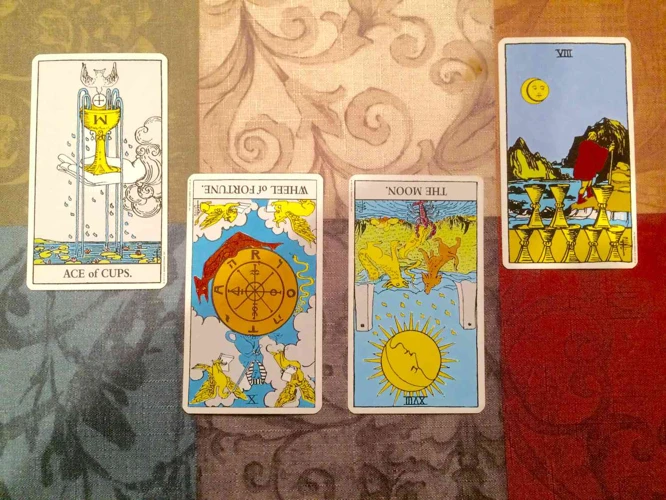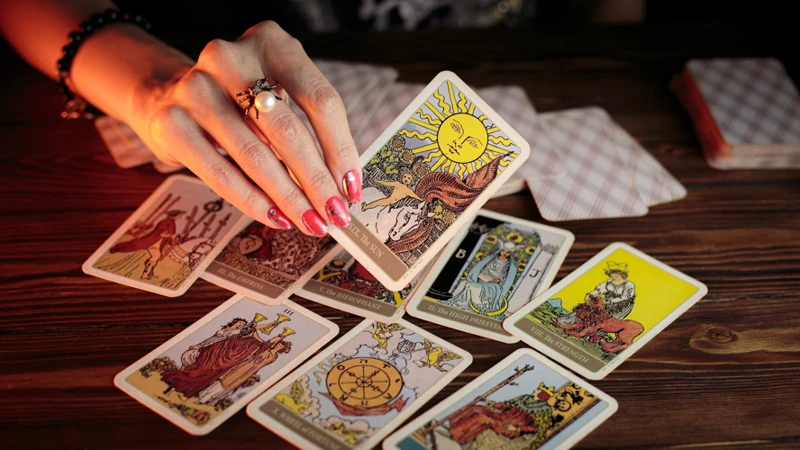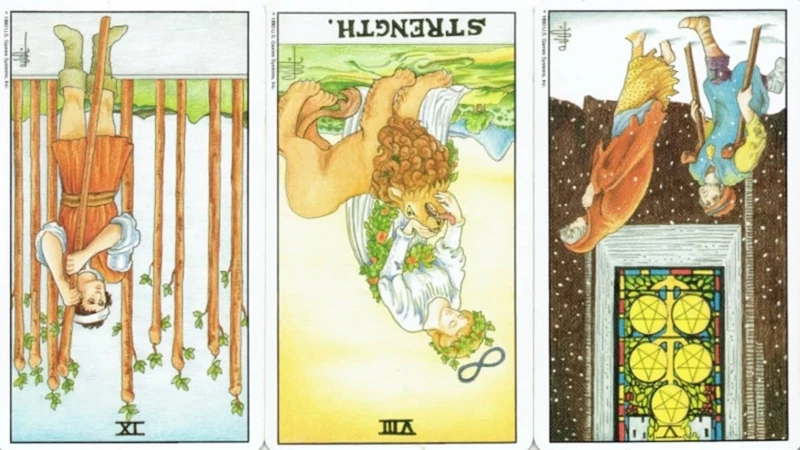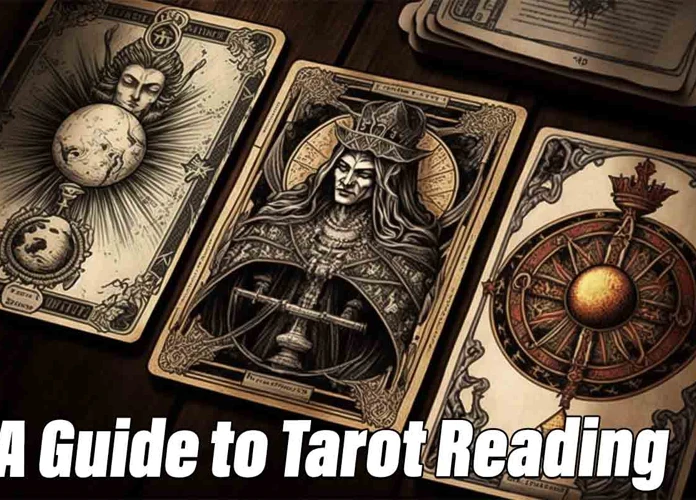Have you ever wondered about the mysterious connection between intuition and the subconscious mind when it comes to interpreting reversed tarot cards? Tarot card readings have been a source of guidance and insight for centuries, and reversed cards add an extra layer of complexity to the practice. In this article, we will dive deep into the world of tarot card reversals, exploring their basics and the different interpretations they can have. We will then examine the role of intuition in tarot reading and the unveiling of the subconscious mind. Finally, we will discuss techniques for interpreting reversed tarot cards by tapping into your intuition and analyzing subconscious influences. By the end, you will have a better understanding of how intuition and the subconscious mind play a crucial role in interpreting reversed tarot cards and blending these two elements together for meaningful insights. Get ready to unlock the hidden messages within the reversed tarot cards!
Contents
- Understanding Tarot Card Reversals
- Intuition and the Subconscious Mind
- Interpreting Reversed Tarot Cards
- Integration of Intuition and the Subconscious Mind
- Conclusion
-
Frequently Asked Questions
- 1. What does it mean when a tarot card is reversed?
- 2. Are reversed tarot cards always negative?
- 3. Can reversed tarot cards change their meanings?
- 4. How can I incorporate intuition into my interpretation of reversed tarot cards?
- 5. Can I use traditional interpretations for reversed tarot cards?
- 6. Should I always read reversed tarot cards differently from upright cards?
- 7. How can I strengthen my intuition when working with reversed tarot cards?
- 8. Can reversed tarot cards indicate hidden influences or subconscious patterns?
- 9. Are there any specific spreads or layouts that work well with reversed tarot cards?
- 10. How do I avoid getting overwhelmed when interpreting reversed tarot cards?
- References
Understanding Tarot Card Reversals

Tarot card reversals add a fascinating dimension to readings, opening up a world of alternative meanings and interpretations. Reversed tarot cards, as they appear upside down, often convey a different energy or message compared to upright cards. While the exact interpretation can vary depending on the reader, there are some general principles to understand. Firstly, reversed cards can represent blocked or suppressed energy, indicating that the card’s usual qualities are being hindered or misunderstood. Secondly, they can signify a need for introspection and reflection, urging us to delve into our subconscious to uncover hidden aspects and emotions. Additionally, reversed cards can encourage us to approach situations from a different perspective or to consider a more unconventional solution. Understanding the contrast between intuitive and traditional interpretations can further deepen our understanding of reversed tarot cards and unleash their full potential.
1. Reversed Tarot Card Basics
Reversed tarot card basics are essential to grasp before delving into interpreting these intriguing cards. When a card appears upside down during a tarot reading, it is considered reversed. The reversal alters the energy and symbolism of the card, presenting a contrast to its upright meaning. Instead of focusing on the positive aspects associated with the card, a reversed tarot card highlights challenges, obstacles, or unresolved issues. Reversed cards often signify blocked energy, indicating that the qualities and lessons typically associated with the card are being hindered or misunderstood. They can suggest a need for introspection and reflection, inviting the reader to explore the deeper, subconscious layers associated with the card’s themes. It is important to note that reversed cards should not be interpreted solely as negative; instead, they offer a complex perspective and a chance to uncover hidden truths. Understanding the basics of reversed tarot cards can provide a solid foundation for strengthening your intuition and developing a nuanced approach to interpreting these cards during readings.
2. Different Interpretations
When it comes to interpreting reversed tarot cards, there is a wide range of different interpretations that can be employed. Tarot readers and enthusiasts often approach reversed cards with a sense of intrigue, as they offer unique insights and perspectives. One common approach is to see reversed cards as a mirror of their upright counterparts, indicating a weakening or distortion of the card’s energy. For example, if an upright card represents success, its reversed counterpart may suggest setbacks or delays in achieving that success. However, it’s important to note that this interpretation is not set in stone and can vary depending on the reader’s intuition and the specific context of the reading. Intuition plays a crucial role in deciphering the meaning of reversed tarot cards. Trusting your instinct and allowing it to guide your interpretation can lead to profound and personal insights. It’s also worth exploring tips for empowering your intuition when working with reversed tarot cards to enhance your interpretive skills. Each reversed card has its own unique story to tell, and by embracing different interpretations, you can unlock a deeper understanding of the messages hidden within the cards.
Intuition and the Subconscious Mind

Intuition and the subconscious mind play crucial roles in the world of tarot card reading. Intuition is the inner knowing, the gut feeling, that transcends logical reasoning and taps into deeper wisdom. When it comes to interpreting tarot cards, intuition serves as a guiding force, allowing the reader to connect with the cards on an intuitive level and receive insights that go beyond surface-level meanings. The subconscious mind, on the other hand, holds a wealth of hidden knowledge and experiences that shape our thoughts, beliefs, and actions. It serves as a reservoir of information that can influence the way we perceive and interpret tarot cards. By accessing both intuition and the subconscious mind, tarot readers can uncover deeper layers of meaning, unravel symbolisms, and gain profound insights into the messages conveyed by the cards. Whether through practical exercises to strengthen intuition or techniques to unveil the power of the subconscious mind, building a strong connection between these two elements elevates tarot card readings to a whole new level.
1. Role of Intuition in Tarot Reading
The role of intuition in tarot reading is absolutely crucial. Intuition is often considered as our inner compass, our instinctual guidance that goes beyond logical reasoning. When it comes to tarot reading, intuition acts as a bridge between the conscious mind and the vast realm of the subconscious. It allows the reader to tap into their inner wisdom and interpret the cards in a way that resonates with their own unique insights and experiences. While there are traditional meanings associated with each tarot card, it is the intuitive connection that brings them to life and adds depth and personalization to the reading. Intuition helps the reader to sense the energy and symbolism of the cards, to pick up on subtle nuances, and to uncover hidden messages or themes that may not be immediately apparent. In fact, some readers exclusively rely on their intuition when interpreting tarot cards, disregarding traditional interpretations altogether. Trusting your intuition allows for a more fluid and organic reading experience, where the cards become a tool for self-reflection and personal growth. It enables you to explore the intricacies of the tarot deck and forge a deeper connection with the mysteries contained within. Developing and honing your intuition is an ongoing process that requires practice, mindfulness, and self-awareness. By harnessing the power of intuition, you can unlock the true potential of tarot readings and unveil profound insights that may have otherwise remained hidden. So, embrace your intuition and allow it to guide you on your tarot reading journey.
2. Unveiling the Subconscious Mind
Unveiling the subconscious mind is an essential aspect when it comes to interpreting reversed tarot cards. Our subconscious mind holds a wealth of information, emotions, and experiences that may not always be accessible to our conscious awareness. When a reversed card appears in a tarot reading, it can serve as a doorway into this hidden realm, offering a glimpse into our deepest thoughts, fears, and desires.
To tap into the subconscious mind while interpreting reversed tarot cards, it is crucial to cultivate a state of openness and receptivity. One effective technique is meditation, which helps quiet the chatter of the conscious mind and allows deeper insights to arise. By stilling our thoughts and focusing our attention on the reversed card, we can create a space for intuitive impressions and symbolism to emerge.
Another way to unveil the subconscious mind is by paying attention to our dreams. Dreams often contain symbolic messages from our subconscious, and by keeping a dream journal and reflecting on the themes and imagery that appear, we can gain valuable insights that can be applied to our interpretation of reversed tarot cards.
Moreover, working with symbolism and archetypes can also help us access the language of the subconscious mind. Tarot cards are rich in symbolism, and each card holds layers of meaning that can resonate with our deeper self. By studying the symbols and connecting them with our personal experiences and emotions, we can unlock the hidden messages within reversed tarot cards.
When interpreting reversed tarot cards, unveiling the subconscious mind allows us to go beyond surface-level meanings and tap into the depths of our intuition. Through practices such as meditation, dream analysis, and working with symbolism, we can develop a profound connection with our subconscious and gain valuable insights that enrich our interpretation of reversed tarot cards.
Interpreting Reversed Tarot Cards

Tarot card readings become even more intriguing when it comes to interpreting reversed cards. To effectively interpret reversed tarot cards, it is important to tap into your intuition and analyze the subconscious influences at play. One approach is to pay close attention to your initial gut reaction when you see a reversed card. A gut instinct can often provide valuable insights into the meaning behind the card’s reversed position. Take a moment to reflect on any emotions or sensations that arise within you. Additionally, consider the symbolism and imagery of the card. Notice any details that stand out or appear different compared to the upright version of the card. These subtle visual cues can hold significant meaning. Another helpful technique is to explore the subconscious influences and underlying themes associated with the card. Journaling or meditation can assist in uncovering any hidden thoughts, fears, or desires that may be influencing the interpretation of the reversed card. By integrating your intuitive guidance and analyzing subconscious influences, you will develop a more nuanced understanding of reversed tarot cards and access the deeper wisdom they hold.
1. Tapping into Your Intuition
Tapping into your intuition is an essential aspect of interpreting reversed tarot cards. Here are some effective techniques to help you connect with your inner wisdom:
- Clear your mind: Before diving into a tarot reading, take a few moments to clear your mind of any distractions or preconceived notions. Find a quiet space where you can relax and focus solely on the cards in front of you.
- Trust your initial impressions: When a reversed tarot card appears, pay attention to your immediate reactions and impressions. Your intuition will often provide you with instant insights and feelings about the card’s meaning. Trust these initial impressions as they can guide you towards a deeper understanding.
- Engage in meditation or mindfulness: Regularly practicing meditation or mindfulness can help sharpen your intuition and create a deeper connection with your subconscious mind. These practices cultivate a state of awareness and presence, allowing you to tap into your intuition more easily during tarot readings.
- Listen to your body: Our bodies often provide subtle signals and sensations that can offer valuable insights. Pay attention to any physical reactions you may experience when encountering a reversed tarot card. These cues can provide clues to the card’s meaning and significance.
- Keep a tarot journal: Maintaining a tarot journal is a wonderful way to develop and trust your intuition. After each reading, write down your immediate interpretations of the reversed cards. Over time, you’ll start to notice patterns and themes that emerge, deepening your intuitive connection.
Remember, intuition is a personal and intuitive process, so trust in your own instincts and interpretations. Let your inner guidance lead you to the hidden messages and insights that reversed tarot cards have to offer.
2. Analyzing Subconscious Influences
When it comes to analyzing subconscious influences in interpreting reversed tarot cards, it is essential to tap into the depths of your intuition and explore the hidden layers of meaning. The subconscious mind holds a treasure trove of information and insights that can greatly enhance your tarot reading experience. One way to unlock these subconscious influences is to pay close attention to your initial gut reactions and emotional responses when you see a reversed tarot card. Trust your instincts and allow your intuition to guide you in deciphering the underlying messages. Often, the first impressions that arise from your subconscious mind are the most authentic and insightful. Additionally, explore the symbolism within the reversed cards and connect them to your personal experiences and emotions. Reflect on how these cards resonate with your subconscious mind and the hidden aspects of your psyche. Journaling about your interpretations can also be a powerful tool in unraveling the subconscious influences at play. By analyzing these subconscious influences, you can gain a deeper understanding of the reversed tarot cards and uncover profound insights that may have gone unnoticed initially. Embrace the mystery and embrace the journey of exploring the intricate connection between intuition and the subconscious mind in interpreting reversed tarot cards.
Integration of Intuition and the Subconscious Mind
Integrating intuition and the subconscious mind is a powerful approach when it comes to interpreting reversed tarot cards. By combining these two elements, readers can gain a deeper understanding of the hidden messages within the cards. Here are some techniques to facilitate the integration of intuition and the subconscious mind:
- Quiet the mind: Before delving into a tarot reading, it’s essential to quiet the mind and create a space for intuition to flow. Meditating, deep breathing, or engaging in calming activities can help clear the mind of distracting thoughts and allow intuitive insights to surface.
- Trust your instincts: Trusting your instincts is crucial when it comes to interpreting reversed tarot cards. Allow yourself to go beyond logical analysis and tap into your gut feelings. Your intuition often holds valuable insights that can complement traditional interpretations.
- Journaling: Keeping a tarot journal can be an effective way to integrate intuition and the subconscious mind. After each reading, take some time to write down your immediate impressions, emotions, and thoughts. Reflecting on the connections between your intuitive hits and the cards can help deepen your understanding of the subconscious influences at play.
- Symbolic exploration: Explore the symbolism present in the reversed tarot cards. Look beyond the traditional meanings and connect with the imagery on a symbolic level. Pay attention to the colors, objects, and patterns within the cards, and allow your subconscious mind to make associations that resonate with you.
By integrating intuition and the subconscious mind, you can unlock a wealth of insights within reversed tarot cards. Embrace your intuitive abilities, trust your instincts, and embark on a journey of self-discovery through the captivating world of tarot readings.
Conclusion
Conclusion:
In conclusion, exploring the connection between intuition and the subconscious mind is vital when interpreting reversed tarot cards. Throughout this article, we have seen how reversed tarot cards add an extra layer of complexity to readings, requiring us to tap into our intuition and delve into the depths of our subconscious. By embracing our intuition, we can access a higher level of understanding and insight that goes beyond traditional interpretations. Additionally, understanding the role of the subconscious mind allows us to uncover hidden influences and emotions that may be affecting the meaning of the reversed cards.
To effectively interpret reversed tarot cards, it is essential to trust your instincts and rely on your intuition. By empowering your intuition, you can develop a deeper connection with the cards and access the hidden messages and meanings they hold. It is crucial to listen to that inner voice and allow it to guide you in understanding the reversed cards.
Moreover, integrating the subconscious mind into tarot card readings enables us to uncover deeper layers of meaning. By analyzing the subconscious influences behind the reversed cards, we can gain valuable insights into our emotions, beliefs, and patterns that may be impacting our current situation. This self-reflection and introspection can lead to personal growth and a better understanding of ourselves and our circumstances.
In summary, the connection between intuition and the subconscious mind plays a significant role in interpreting reversed tarot cards. By harnessing our intuition, embracing the complexities of reversed cards, and delving into the realms of the subconscious mind, we can unlock profound insights and guidance from the tarot. So, the next time you encounter a reversed tarot card, remember to trust your intuition, explore the depths of your subconscious, and allow the cards to reveal their hidden wisdom.
Frequently Asked Questions
1. What does it mean when a tarot card is reversed?
When a tarot card is reversed, it means that it appears upside down during a reading. This reversed position adds an additional layer of meaning and energy to the card’s interpretation.
2. Are reversed tarot cards always negative?
No, reversed tarot cards are not always negative. While they can indicate challenges or blocked energy, they can also offer valuable insights, alternative perspectives, or hidden opportunities that may not be immediately apparent.
3. Can reversed tarot cards change their meanings?
Yes, reversed tarot cards can change their meanings from their upright counterparts. The reversed position may suggest a need to explore the shadow aspects of the card or offer a more nuanced interpretation based on the specific question or situation.
4. How can I incorporate intuition into my interpretation of reversed tarot cards?
To incorporate intuition into interpreting reversed tarot cards, trust your instincts and pay attention to any intuitive flashes or gut reactions you may experience. Allow your intuition to guide you in understanding the subtleties and hidden messages conveyed by the reversed cards.
5. Can I use traditional interpretations for reversed tarot cards?
While traditional interpretations can provide a foundation, interpreting reversed tarot cards often requires adjusting or expanding upon those meanings. Consider blending traditional interpretations with your intuition to create a more comprehensive understanding of the reversed cards.
6. Should I always read reversed tarot cards differently from upright cards?
Reading reversed tarot cards differently from upright cards is a personal choice. Some readers prefer to assign opposite or contrasting meanings to the reversed cards, while others interpret them as a more subtle variation of the upright card’s energy. Experiment and find an approach that resonates with you.
7. How can I strengthen my intuition when working with reversed tarot cards?
There are various practices to strengthen your intuition when working with reversed tarot cards. Some techniques include meditation, journaling, visualizations, and practical exercises designed to enhance your intuitive abilities.
Absolutely! Reversed tarot cards can often reveal hidden influences and subconscious patterns that are at play in a situation. They can serve as subtle signals to dive deeper into your subconscious and explore the underlying factors affecting the current circumstances.
9. Are there any specific spreads or layouts that work well with reversed tarot cards?
While there are no hard and fast rules, spreads that incorporate positions specifically for reversed cards can provide greater insight into their meanings. You can modify existing spreads by assigning positions for reversed cards or even create your own spread tailored to working with reversed tarot cards.
10. How do I avoid getting overwhelmed when interpreting reversed tarot cards?
Interpreting reversed tarot cards can sometimes feel overwhelming, especially when starting out. Take it step by step, focusing on one card at a time. Consider keeping a tarot journal to record your impressions and reflections, which can help in maintaining clarity and managing the complexity of reversed cards.






